|
Abstract
This paper describes some
interesting observations made during our work with the 'Water
Breeding Cell' research. We were able to observe and photograph
significant increases in water tension (bond strength) caused by the
application of regulated high voltage electrostatic charge to the
breeding cell while exposing the cell input air column to a specific
static high voltage.
We call one of the
observations 'Water Saucers' as they closely resemble what is
sometimes referred to as a flying saucer. The 'Water Saucers' are
not bubbles, they are indeed a single sheet of water lifted up
the cell tube by the incoming air pressure, and only appear with
specific electrode placement and excitation voltage.
Introduction
This is a short paper
covering observations obtained from research into the 'Water
Breeding Cell'. During our work we observed some strange and
unexpected reactions to the breeding cell water when exposed to
certain voltages and input air pressures along with special
excitation electrodes placed at specific places in the air and water
columns. Because the 'Water Saucers' are not bubbles and the way in
which they were observed to react during their travel up the cell
column, required additional attention to determine their
significance.
The following images of
'Water Saucers' show the saucers being generated in a water
breeding cell that has an inside diameter of 1” or approx; 25
mm. The saucers would generate at the surface of the cell water
and migrate up the 22 mm cell tube for some 15 cm, to the top
where they would collapse. Upon collapse the water that was in
the saucer would run back down the cell tube to the surface.
What was very
interesting was the large surface tension present in the 'Water
Saucers' to allow them to form and span the entire inner surface
of the cell tube. The saucer shape can be clearly seen as Convex
at the top (dome) and Concave on the underside. It is clearly
visible in the images that the saucers are not bubbles, but
actual sheets of tensioned water moving up the cell tube.
During the saucer
travel from generation to the end of its life at the top of the
cell, the dome size will increase in height, showing the high
surface tension present in the molecular structure. When a saucer
is first formed at the surface of the cell supply, the saucer is
flat. Once it separates from the surface it begins to form the
dome. As the saucer moves upward the dome increase in height with
a corresponding convex dimple on the underside.
The saucers are
supported and attracted by electrical charge at their contact
point with the plastic cell tube and the negative charge of the
environmental air surrounding the cell tube. During the upward
travel, a saucer can be destroyed if discharged by a large amount
of water running down the side of the tube and returning to the
surface. This water that is returning is from the prior
extinction of preceding saucers. A large saucer having collapsed
can inhibit the generation of new saucers until the volume of
returning water is small enough to no longer discharge a new
forming saucer. We further observed that the volume of the
returning water had to be of sufficient amount to cause a saucers
discharge or the moving saucer would pick up the returning water,
adding it to its own volume while moving up the tube.
This first image clearly shows
the shape of a 'Water Saucer', remembering that the saucer has a
diameter of some 25 mm with an increasing dome height of from 0-5 mm
as it rises in the tube.
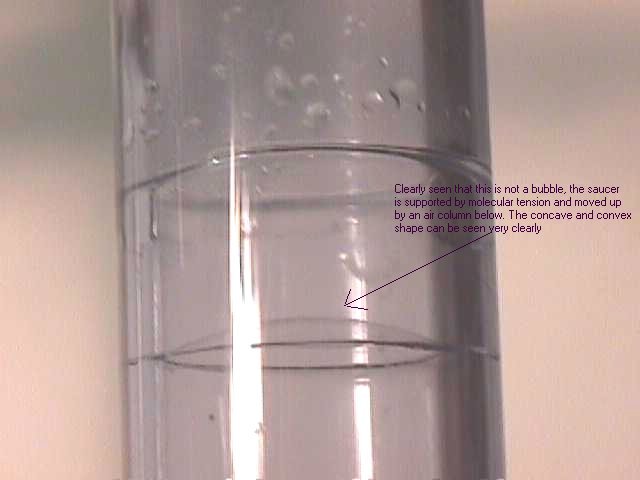
The next image is interesting as two
properly formed 'Water Saucers' are observed at the top and followed
by an improperly formed saucer containing an actual air bubble
attached to the underside of its dome.
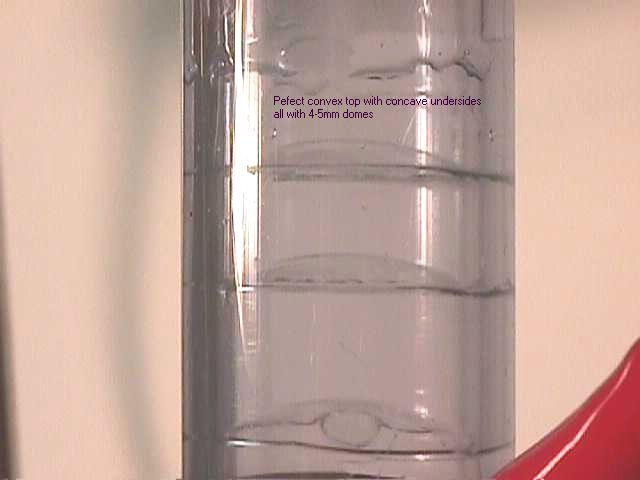
The next photo shows three formed 'Water
Saucers' from a view back away from the cell tube. The top saucer is
about ready to self destruct as seen in the expanding size of its
dome. Once the dome exceeds a height great enough to no longer be
supported by the increased molecular tension, the saucer will break
and discharge, the water will fly to the sides of the tube where it
will run down and return to the surface.
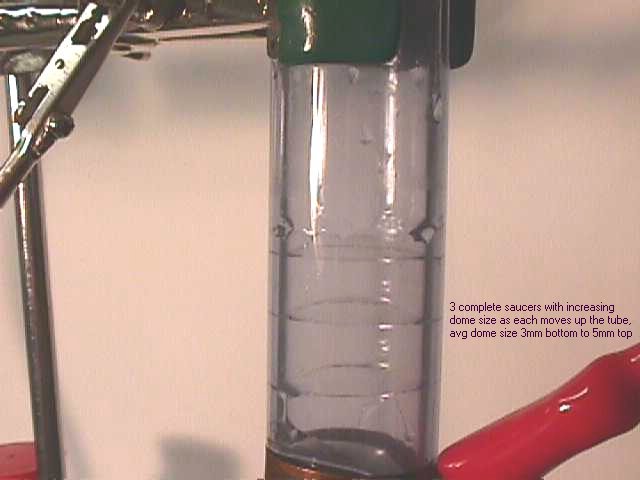
This last image shows a single saucer with a
huge 5 mm dome as it reaches the half way point on its travel up the
tube. This saucer destroyed itself just after the photo was
taken.
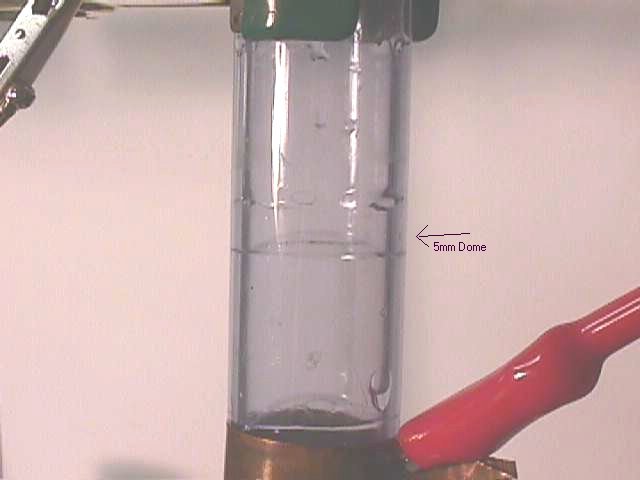
The following image is taken
before a breeder cell is placed in operation, just after it was
charged with fresh breeder water. The image shows the water line in
the air input tube which starts out with a small quantity of water
which is moved into the breeder during operation by the operational
air pressure. What is to be noted is the normal looking surface of
the water line, it appears level with a slight concave shape in the
center. While the edges are slightly broadened where the water
adheres to the plastic tubing. All of this is what would be
expected.
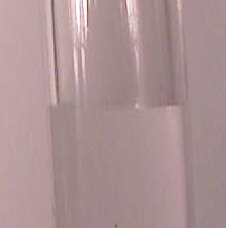
The image that follows was taken after a
normal breeder cell test run and it shows the effect of the charge
being held by the water. This image is of the air input tube as
shown in the preceding image after the cell was shut down and
pressure released to allow all remaining water levels to regain
equilibrium. Voltage was removed prior to the pressure release. The
Dome shape of the water can easily be seen in contrast to the
preceding picture. The dome measures 6 mm in height and the outer
edge of the surface touching the plastic tube is pulling away,
rather than adhering as would normally be seen.
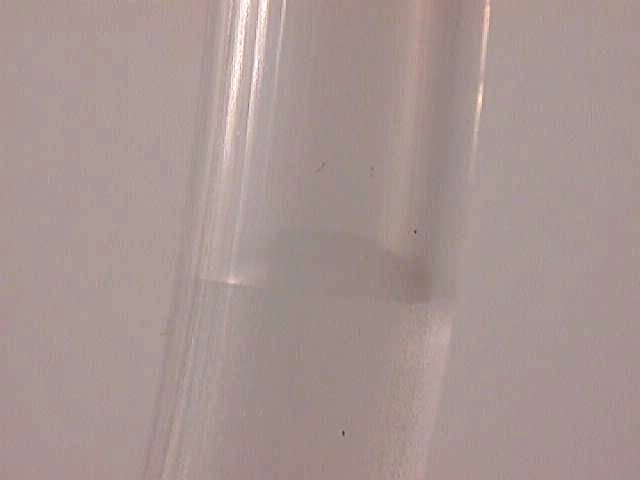
If the cell is allowed to sit undisturbed, the water will hold
significant charge for three to four hours, at which time it
begins to dissipate. This dissipation is because the normalized
cell is not sealed to the environment which contains sufficient
ions to begin the charge reduction.
Our work with the 'Water Breeder' uses two different cell
arrangements, one is designated the HWBC and the other is the
VWBC. The 'H' and 'V' prefix stands for Horizontal and Vertical.
When we decided to prepare this paper we were working with the
VHBC and wanted to know if we could produce a similar set of
conditions in the HWBC, even though it operates in a somewhat
different way.
Before connecting up the HWBC to modify the
operational parameters we could not envision just how the increased
tension could be seen in a similar way to the rising dome (above
images), yet we proceeded. What follows of great surprise to say the
least.
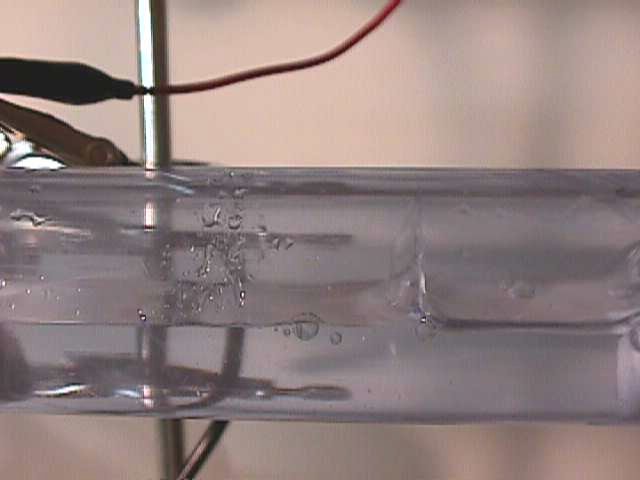
What appeared so startling was we had indeed
created a very similar water mass, only in the vertical rather than
horizontal. In addition the shape and volume of water contained was
much greater than ever observed in the vertical cell. The most
important feature is the form extends into the body of the cell
water (bottom of cell with air space above) and moves through the
water with the rest of the exposed saucer. One can easily see the
wave front preceding the saucer as it moves, a build up of water
being pushed along by the mass of the water saucer moving towards
the outlet.
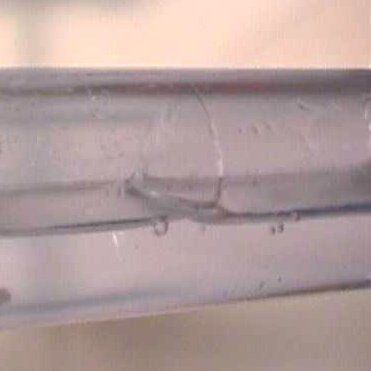
|

